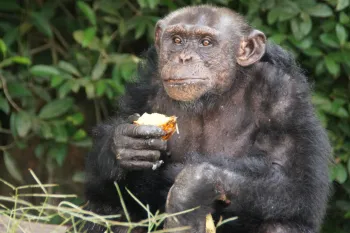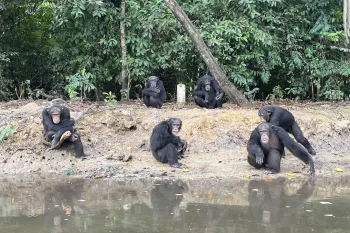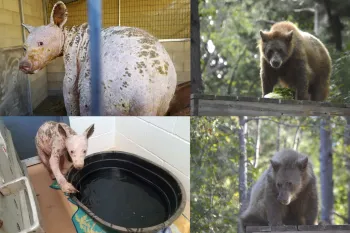MONROVIA, Liberia—In advance of World Chimpanzee Day (July 14), animal charity Humane World for Animals (formerly called Humane Society International) has released thought-provoking photographs of some of the oldest residents at its Second Chance Chimpanzee Refuge in Liberia, who endured decades of invasive experiments at a research laboratory in the country.
Second Chance, located on a set of estuarine islands, is the only sanctuary in Africa to care for former laboratory chimps; most of the 61 residents were either stolen from their families in the wild and later sold to the laboratory or born in captivity as part of the lab’s breeding colony. Collectively, they were subjected to at least 500 liver biopsies and tranquilized or anaesthetized over 4,000 times.
Photographs released by the charity of some of the sanctuary’s oldest residents, combined with heartbreaking details from their old laboratory records, reveal a fascinating insight into what these resilient chimpanzees have lived through. This includes being stolen from the wild as babies, enduring decades of invasive experiments and frightening tranquilizations, injuries from lab accidents as well as infections and illnesses, the loss of their infants, Liberia’s civil war, and ultimately, abandonment on the islands.
Humane World for Animals says the photographs and stories of Samantha, Springroll, Stuart, Brutus, David, Jiminy Cricket, Saffa, Lolo, Sally and Bullet are a much-needed reminder that animals used in experiments are individuals with personal experiences who suffer greatly behind closed laboratory doors.
- Samantha: at 51 years old, Samantha is the oldest chimp at the sanctuary. She was born in the wild in 1974, but her family was killed by poachers, and she was sold to the lab by a local villager at just one and half years old. For nearly 30 years she endured invasive research. At the lab’s breeding colony, she gave birth to three babies, all of whom tragically died soon after.
- Stuart: born at the laboratory in 1988, Stuart was almost immediately used in harmful research without anesthesia until he was one and a half years old. He was separated from his mother at just two years old and experimented on for over a decade and a half. Stuart’s lab records refer to him as “notorious” for throwing feces at lab workers to protect other chimps.
- Saffa: born in 1979, Saffa arrived at the lab in 1981 as a very sick two-year-old. Within months of his arrival, the experiments began; in addition to over 100 liver biopsies, he endured over 500 tranquilizations over nearly 30 years. Now 46 years old, Saffa has no teeth left due to infant malnutrition, poor diet at the lab and old age.
- Bullet: Bullet was born in the wild in 1977 and hit by the pet trader’s bullet that killed his mother. He was sold to the lab aged 3 years old for $150 where an infection in his bullet wound eventually led to his arm being amputated. Following surgery, Bullet was soon being used in research that would continue for 20 years including 55 liver biopsies, more than 400 tranquilizations and hundreds of blood draws. He would shake the cage bars and scream loudly when he saw a tranquilizer gun.
Jallah Fahnbulleh, government liaison officer at Humane World for Animals Liberia, said: “Most of the chimps in our care have endured a lifetime of suffering at the hands of poachers, as victims of the pet trade and as experimental subjects in research. They still carry the emotional and physical scars of that trauma years later, but at least we have been able to give them back their freedom and their dignity living near-wild at our sanctuary. So much of their lives were stolen from them but we hope that in some small way, here at Second Chance, they are living the kind of life they have always deserved. Seeing them build nests in the trees, groom each other and flourish in the companionship of their bonded groups, is a daily privilege. They have known the worst of humanity but also, I hope the best too.”
The chimps were retired to the islands along the Farmington and Little Bassa rivers (30 miles from the Liberian capital, Monrovia) in the early to mid-2000s when the lab ended its chimpanzee experiments and later withdrew funding. Staff members continued to bring the chimps food and water as neither was naturally abundant on the islands. In 2015, Humane World for Animals stepped in and pledged lifetime care for the chimps who now live a near-wild forest existence on the islands which the charity runs as a sanctuary. Its dedicated team―some of whom are the original caregivers from the lab―visit the chimps twice a day every day to deliver fresh fruit, vegetables and water.
To accommodate an aging population of chimpanzees, some still living with health issues from their laboratory days, Humane World for Animals is building new structures on each island to make vital veterinary care quicker and easier. This multi-year project will mean that the chimps can be left as undisturbed as possible even when receiving more hands-on healthcare for ailments, minor surgeries, routine check-ups and diagnostic procedures.
#



